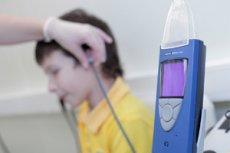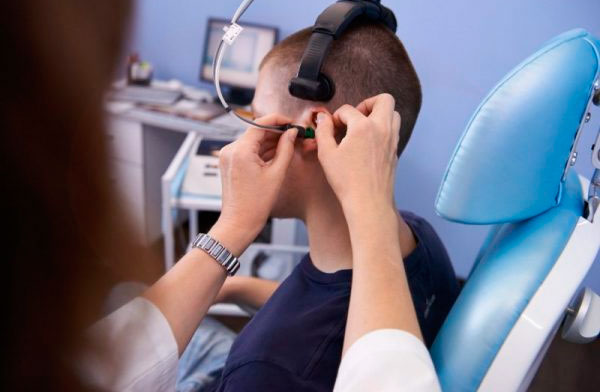Medical expert of the article
New publications
Tympanometry
Last reviewed: 03.07.2025

All iLive content is medically reviewed or fact checked to ensure as much factual accuracy as possible.
We have strict sourcing guidelines and only link to reputable media sites, academic research institutions and, whenever possible, medically peer reviewed studies. Note that the numbers in parentheses ([1], [2], etc.) are clickable links to these studies.
If you feel that any of our content is inaccurate, out-of-date, or otherwise questionable, please select it and press Ctrl + Enter.

Tympanometry is a method of examining the eardrum.
This is done with a special probe that reproduces a series of different frequencies. As a rule, they range from 200 to 1500 Hz. Thanks to this method, it is possible to determine the resonant frequency of the middle ear system. In an adult, this figure is 900 Hz.
Indications for tympanometry
Indications for tympanometry are in every way related to hearing problems. Thus, there may be fluid in the middle ear and to check this condition, it is necessary to perform some manipulations. The procedure is also performed in case of perforation of the eardrum.
The main indication may be a tumor in the middle ear. Trauma to the eardrum is not excluded. Tympanometry is also performed in the presence of a wax plug. Finally, it may be some kind of conductivity disorder of the bones in the middle ear.
This procedure is mainly performed for inflammatory diseases of the ear. It allows to assess the presence of fluid in the middle ear cavity. This manipulation also takes place in case of damage to the auditory nerve. It is also performed in children with adenoiditis. And finally, tympanometry is performed as a comprehensive diagnosis of hearing loss in adults and children. In some cases, it is used for differential diagnosis of various ear diseases.
How is tympanometry performed?
In fact, the procedure is very simple and does not require additional preparation. First, the doctor examines the ear using an ordinary funnel. This will allow him to make sure that there are no foreign bodies in the hearing organs, including earwax.
After this, the patient receives recommendations regarding behavior during this procedure. It is forbidden to talk, swallow saliva, chew or move. All this can make unpleasant adjustments to the results of the study. As a result, the person will receive inaccurate data.

At the next stage, a special probe is inserted into the ear. After this, air is pumped in using a pump, which is sucked back out at the same second. This creates pressure on the eardrum and makes it move. The resulting pressure is then assessed. At the same time, a special sound signal is emitted. Thanks to it, the sound reflection from the eardrum is assessed. Based on the data obtained, a conclusion is made.
During the procedure itself, a person may feel slight pressure in the ear and, naturally, ringing sounds. The procedure is completely painless and has no contraindications. Tympanometry is performed for 5-10 minutes.
Conducting tympanometry on a child
Tympanometry is also performed on a child if there is a risk of earwax or adenoiditis. The latter disease is characterized by the growth of adenoids. The procedure, in turn, allows you to assess the degree of this pathology and make a conclusion about the possibility of conservative treatment.
For children, the examination is carried out in the same way as for adults. There are no differences. It is important to explain to the child how to behave and what not to do before the procedure. It is worth mentioning right away that the procedure is painless. Therefore, the baby has nothing to be afraid of. It should be explained to the child that during the manipulation, it is forbidden to move, talk, swallow saliva and chew. All this will negatively adjust the result of the study. There are no age restrictions for this procedure. Tympanometry is carried out even on newborns. It does not have any negative effects, is not capable of harming the body and, moreover, lead to the appearance of painful sensations.
Contraindications to tympanometry
This procedure is completely safe and cannot harm human health. But, despite this, it is not worth doing it without consulting a doctor. After all, all people are unique in themselves and the frequency of sound perception by the hearing organs can be different.
Therefore, before going to the procedure, it is worth visiting a therapist. Basically, it is he who issues a referral for this method or recommends to undergo it independently.
Today, many people use this procedure. After all, it is very effective. Thanks to it, you can notice neoplasms in the middle ear and prevent the development of serious diseases. The procedure is completely safe. Moreover, it can be carried out even on newborns, which makes the task of diagnosing ear problems several times easier. Tympanometry is truly a new breakthrough in medicine, because it is not always so easy to determine the reason why a person is bothered by the hearing organs.
Decoding tympanometry
Tympanometry is deciphered by a doctor. A person is unlikely to be able to understand anything on their own. At the end of the procedure, they are given a sheet with the results. As a rule, these are graphs and a description. Thanks to such a picture, you can assess the real state of affairs. The graphs show the ear's sensitivity to sounds and data regarding pressure.
Sounds of different frequencies are fed to the person's hearing organs and, based on this, a conclusion is made regarding his susceptibility. Thanks to this procedure, it is easy to determine the presence of any deviations. The health worker who performs this procedure does not decipher. Usually, this fate befalls the ENT specialist. After all, it is he who must send the patient for this procedure if he is worried about any deviations or if there is a risk of developing a disease of the hearing organs. The result is extremely clear, but only for a specialist. Based on the data, he makes a diagnosis. Tympanometry is a universal procedure that will allow you to notice any deviations.
Tympanometry type C
Tympanometry type c means that the peak of the curve is shifted to the left. This is usually a sign of negative pressure in the tympanic cavity. After the procedure, a person receives a sheet of data. They contain graphs and a description. From the graphs, you can understand the limits of the pressure in the organs of hearing and how things are with the reflection of sound from the eardrum.
But in order to make an accurate diagnosis, it is necessary to start from some norm. So, there are several types of tympanometry. The first type A, it indicates that all indicators are within the normal range. The peak of the graph is located exactly in the middle. The second type B, it shows a flat curve, which indicates effusion in the eardrum. Type C, as mentioned above, means negative pressure. There are no other variations of decoding. Tympanometry allows you to assess the condition of a person's hearing organs using graphs and make a conclusion based on the data obtained.
Where to get tympanometry done?
Not many people know where to do tympanometry. In fact, this procedure is carried out in almost every clinic. Naturally, modern equipment is necessary. Therefore, if it is not possible to perform the procedure in a city clinic due to the lack of equipment, the person is sent to another place. Usually these are general clinics that specialize in this issue.
Usually after the examination the doctor gives a referral for the procedure. In modern clinics everything is done quickly and painlessly. The duration of all manipulations is 5-10 minutes. At the end of the specified time the person receives a sheet with the results. It shows two graphs and a description. The graphs indicate the frequency of sound perception by the ear and the pressure. With the received data the patient goes to his doctor to decipher the information. The medical workers conducting the procedure do not decipher. Tympanometry can be carried out absolutely anywhere where the necessary equipment is available.
Tympanometry does not require any preparation or testing. This means that there will be no additional costs. Naturally, it is better to do the procedure in a modern clinic on good equipment. It may cost a little more, but the result will be accurate. It is important to follow all the rules when performing the procedure. Otherwise, tympanometry will show an unreliable result and will have to be redone, and this will already be additional costs.


 [
[